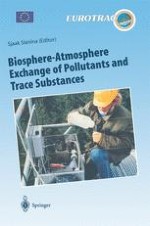1997 | OriginalPaper | Buchkapitel
Atmospheric Particles and their Interactions with Natural Surfaces
verfasst von : Martin Gallagher, Jacques Fontan, Paul Wyers, Walter Ruijgrok, Jan Duyzer, Paul Hummelshøj, Kim Pilegaard, David Fowler
Erschienen in: Biosphere-Atmosphere Exchange of Pollutants and Trace Substances
Verlag: Springer Berlin Heidelberg
Enthalten in: Professional Book Archive
Aktivieren Sie unsere intelligente Suche, um passende Fachinhalte oder Patente zu finden.
Wählen Sie Textabschnitte aus um mit Künstlicher Intelligenz passenden Patente zu finden. powered by
Markieren Sie Textabschnitte, um KI-gestützt weitere passende Inhalte zu finden. powered by
The purpose of this short review will be to focus on those aspects of aerosol exchange which are of importance to the BIATEX community in order to aid in the assessment of acidic or alkaline deposition, from dry and wet aerosol (in the form of cloud or fog droplets) over Europe with an eye to the larger scale processes in which aerosols play a critical role. One of the important goals of the Biatex program, emphasised by its co-ordinator, has been the necessity to deliver information about these processes which are “useful” to wider interests, in particular the modelling community. In light of the co-ordinators plea for “immediately useful information” a detailed summary of parameterisations which have been forthcoming in BIATEX and related programmes for both dry and wet aerosol deposition are listed in the Appendix.Within the BIATEX program paniculate deposition has not received as much attention as has trace gas exchange and is an area which still requires much investigation. Encouragingly, recent work reported at the EUROTRAC BIATEX workshop in Madrid, 1995, has produced reliable parameterisations that are now well supported by a growing experimental database. The results reported were obtained using very different instrumentation and measurement techniques and this strengthened the final conclusions drawn. The oft held view that there is significant disagreement surrounding dry deposition measurements would appear to recede in the light of these results. In particular there has been pleasing agreement between measurements of dry deposition velocity, Vd, for aerosols to forest canopies by micrometeorological techniques and throughfall-stemflow or surface type measurements quoted in the literature. The eddy correlation (EC) technique employed for aerosol flux measurements which has often been plagued by susceptibility to low-frequency contamination and instrumental limitations has significantly benefited from the work of Lamaud et al. (1994) who show that aerosol fluxes cannot be “blindly” computed using the analysis techniques generally used for trace gas fluxes.We are now confident that the dry deposition velocity is well defined by measurement for typical atmospheric aerosol loadings, probably better than to within a factor of 2. Gaps still exist in our understanding of the detailed particle size dependence for the various physical transport processes in the crucial size region 0.1–1.0 μm. The classical model picture handed down to us, and based on wind tunnel data does not take into account the influence of e.g. stability and related burst effects, and would appear to underestimate deposition velocities in this size range for rough vegetation. It still remains for the latest experimental results to be compared in detail with the latest models, which are now beginning to address this discrepancy by the inclusion of additional transport mechanisms.
